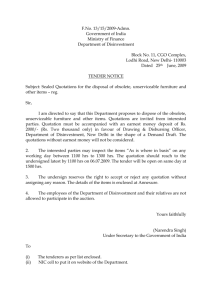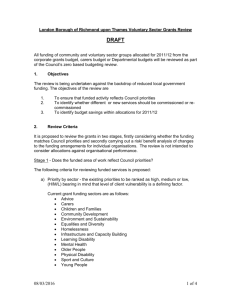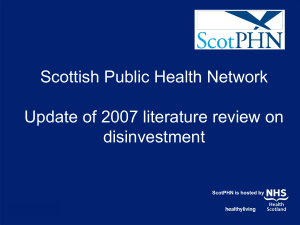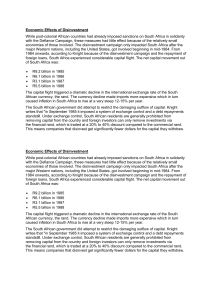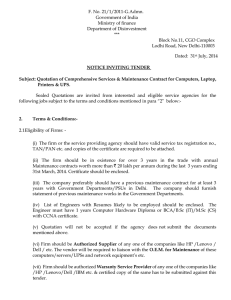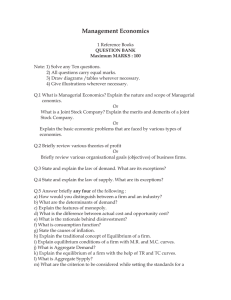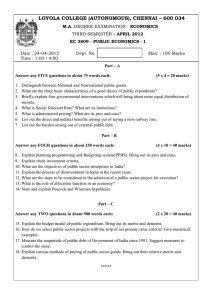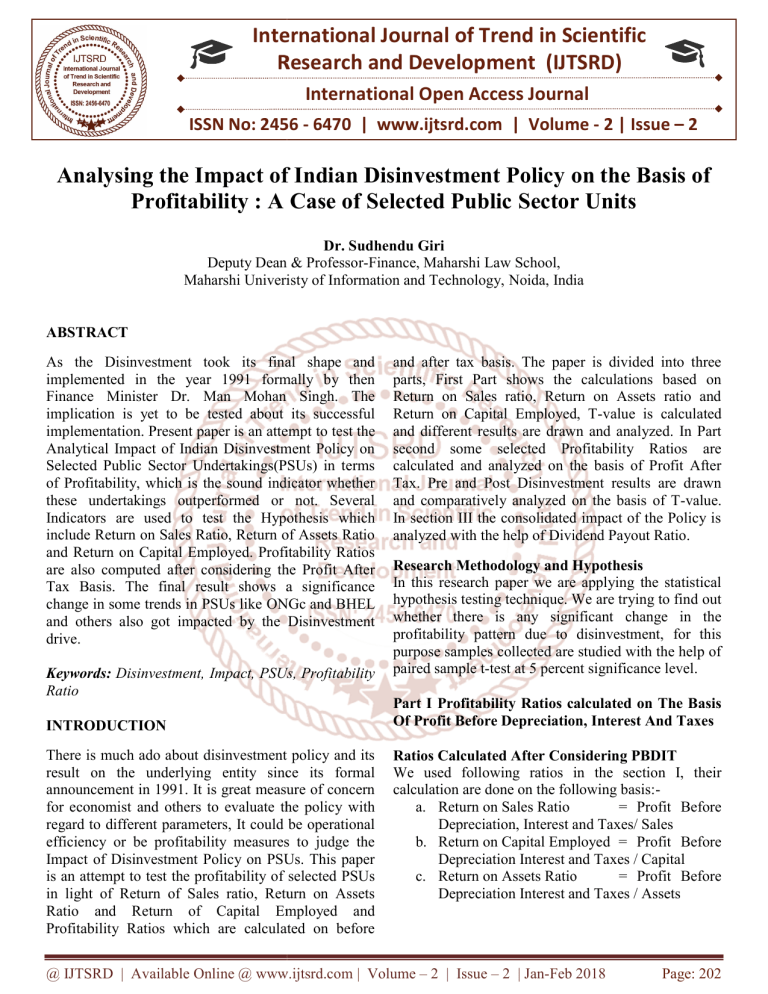
International Journal of Trend in Scientific
Research and Development (IJTSRD)
International Open Access Journal
ISSN No: 2456 - 6470 | www.ijtsrd.com | Volume
me - 2 | Issue – 2
Analysing the Impact off Indian Disinvestment Policy on
o the Basis of
Profitability : A Case off Selected Public Sector Units
Dr. Sudhendu Giri
Deputy Dean & Professor
Professor-Finance, Maharshi Law School,
Maharshi Univeristy of Information and Technology, Noida,, India
ABSTRACT
As the Disinvestment took its final shape and
implemented in the year 1991 formally by then
Finance Minister Dr. Man Mohan Singh. The
implication is yet to be tested about its successful
implementation. Present paper is an attempt to test the
Analytical Impact of Indian Disinvestment Policy on
Selected Public Sector Undertakings(PSUs) in terms
of Profitability, which is the sound indicator whether
these undertakings outperformed or not. Several
Indicators are used to test the Hypot
Hypothesis which
include Return on Sales Ratio, Return of Assets Ratio
and Return on Capital Employed. Profitability Ratios
are also computed after considering the Profit After
Tax Basis. The final result shows a significance
change in some trends in PSUs like ONGc and BHEL
and others also got impacted by the Disinvestment
drive.
Keywords: Disinvestment, Impact, PSUs, Profitability
Ratio
INTRODUCTION
There is much ado about disinvestment policy and its
result on the underlying entity since its formal
announcement
ent in 1991. It is great measure of concern
for economist and others to evaluate the policy with
regard to different parameters, It could be operational
efficiency or be profitability measures to judge the
Impact of Disinvestment Policy on PSUs. This paper
is an attempt to test the profitability of selected PSUs
in light of Return of Sales ratio, Return on Assets
Ratio and Return of Capital Employed and
Profitability Ratios which are calculated on before
and after tax basis. The paper is divided into three
parts, First Part shows the calculations based on
Return on Sales ratio, Return on Assets ratio and
Return on Capital Employed, T-value
T
is calculated
and different results are drawn and analyzed. In Part
second some selected Profitability Ratios are
calculated
ated and analyzed on the basis of Profit After
Tax. Pre and Post Disinvestment results are drawn
and comparatively analyzed on the basis of T-value.
T
In section III the consolidated impact of the Policy is
analyzed with the help of Dividend Payout Ratio.
Research
search Methodology and Hypothesis
In this research paper we are applying the statistical
hypothesis testing technique. We are trying to find out
whether there is any significant change in the
profitability pattern due to disinvestment, for this
purpose samples
ples collected are studied with the help of
paired sample t-test
test at 5 percent significance level.
Part I Profitability Ratios calculated on The Basis
Of Profit Before Depreciation, Interest And Taxes
Ratios Calculated After Considering PBDIT
We used following
owing ratios in the section I, their
calculation are done on the following basis:basis:
a. Return on Sales Ratio
= Profit Before
Depreciation, Interest and Taxes/ Sales
b. Return on Capital Employed = Profit Before
Depreciation Interest and Taxes / Capital
c. Return on
n Assets Ratio
= Profit Before
Depreciation Interest and Taxes / Assets
@ IJTSRD | Available Online @ www.ijtsrd.com | Volume – 2 | Issue – 2 | Jan-Feb
Feb 2018
Page: 202
International Journal of Trend in Scientific Research and Development (IJTSRD) ISSN: 2456-6470
The following Hypothesis is designed for the purpose
of testing the difference between pre disinvestment
and post disinvestment ratios of profitability:Ho1:- RoS ratio between pre disinvestment period
and post disinvestment period is not statistically
different. RoSa=RoSb
H11: RoS ratio between pre disinvestment period and
post disinvestment period is statistically different.
RoSa ≠ RoSb.
Ho2:- RoA ratio between pre disinvestment period
and post disinvestment period is not statistically
different. RoAa = RoAb.
H12:- RoA ratio between pre disinvestment period
and post disinvestment period is statistically different.
RoAa ≠ RoAb.
Ho3: RoCE between pre disinvestment period and
post disinvestment period is not statistically different.
RoCEa = RoCEb.
H13: RoCE between pre disinvestment period and
post disinvestment period is statistically different.
RoCEa ≠ RoCEb.
The above hypothesis focuses on to test the extent of
performance difference of PSUs on the basis of their
pre disinvestment period and post disinvestment
period. It is also tried to find out and identify the
extent of difference. We used the symbols a and b for
pre disinvestment period and post disinvestment
period.
1.a
Analysis
of
Ratio(PBDIT/SALES)
Return
on
Sales
We computed the RoS ratio for the selected PSUs for
both pre disinvestment period and post disinvestment
period which is presented in Table 1. A comparative
overview between pre disinvestment period and post
disinvestment period is presented in Table as under:--
Table:-1
Return of Sales Ratio
(PBDIT/SALES)*100
Mean(After) Mean(Before) Mean Diff.
T-Value
ONGC
58.337404
43.457798
14.879606
4.785
7.8336387
8.24309
-0.4094513
-0.381
HPCL
17.587297
20.1197468
-2.5324498
-1.783
BEL
33.77965
38.06789
-4.28824
-0.839
CONCOR
7.9845606
7.7634193
0.2211413
0.238
IOCL
MTNL
46.837982
58.451396
-11.613414
-3.174
BEML
10.4778901
21.6371279 -11.1592378
-7.833
16.908725
14.673819
2.234906
0.975
BHEL
25.973122
32.208750
-6.235628
-0.563
GAIL
7.7892778
8.8796552
-1.0903774 -1.0964
BPCL
Source: Compiled from the various issues of Public Enterprises Survey.
D.F.
8
8
8
6
8
8
8
9
8
9
@ IJTSRD | Available Online @ www.ijtsrd.com | Volume – 2 | Issue – 2 | Jan-Feb 2018
Sig.level
(2-Tailed)
.018
.876
.168
.639
.245
.005
.002
.673
.564
.223
Page: 203
International Journal
nal of Trend in Scientific Research and Development (IJTSRD) ISSN: 2456-6470
2456
Figure:1
25
20
15
Mean(After)
10
Mean(Before)
5
0
The difference between pre disinvestment period and post disinvestment period is evident from Table 1. We
computed the Return on Sales ratio for various Public Sector Undertakings (PSUs) by dividing PBDIT by
SALES for both pre disinvestment period and post disinvestment period. It is clear from the Table 1 above that
concerned ratio (RoS) reported an increasin
increasing
g trend only in the case of ONGC, IOCL and BHEL after the period
of disinvestment but it is also clear from the above Table that other PSUs included in the study shown a better
performance in terms of RoS ratio before disinvestment period. Hence, we are aable
ble to conclude that the major
part of our study sample is not affected by the disinvestment policy and their performance is not improved with
the inclusion of this policy. We computer the T
T-value
value for the purpose of finding out the difference on RoS ratio
and its statistical significance for both pre disinvestment period and post disinvestment period. We can
conclude from our finding that there is a significant difference for the PSUs like ONGC, MTNL IOCL and
BEML but against it, all the other sample units the result is found as not statistically significant for RoS ratio
for pre disinvestment period and post disinvestment period. If we do more analysis on the facts from Table 1
that it can be easily ascertained that ONGC shown favorable results after Disin
Disinvestment
vestment took place as its
computed mean return after Disinvestment is in increasing trend. However, if we look at other PSUs like
MTNL, BEML and GAIL we will be able to come to a conclusion that their mean returns for the pre
disinvestment period were higher
than those of post disinvestment period and Disinvestment policy affected them negatively.
1.b Analysis of Return on Assets Ratio(PBDIT/ASSETS)
We calculated the value of Return on Assets ratio for both pre disinvestment period and post disinvestment
disinvestm
period which is presented in Table 2 that clearly exhibits the results regarding difference between after and
before disinvestment period. We used T
T-test
test to judge whether there is significant difference exist between the
two periods or there is not any significant difference between the after and before disinvestment period. The
ratio RoA is calculated by applying the formula Profit Before Depriciation, Interest and Taxes divided by
Assets for both the said two periods.
Exhibits in Table 2 presents the complete picture of Pre and Post Disinvestment period on the basis of Return
on Assets ratio.
@ IJTSRD | Available Online @ www.ijtsrd.com | Volume – 2 | Issue – 2 | Jan-Feb
Feb 2018
Page: 204
International Journal
nal of Trend in Scientific Research and Development (IJTSRD) ISSN: 2456-6470
2456
Table:2
Return on Asset Ratio
(PBDIT/ASSET)*100
Mean(After) Mean(Before) Mean Diff. T-Value
ONGC
29.172799
19.298713
2.113691
2.193
HPCL
19.613497
21.132496
-4.254481
-3.191
13.276349
11.663951 11.846264
1.431
BEL
CONCOR
33.977394
17.893761 -28.781466
7.293
15.976609
14.893129 -19.402157
0.413
IOCL
15.302293
17.498319
1.792673
-1.281
MTNL
BEML
7.311498
12.391781
-8.478358
-12.133
11.973419
10.383619
-1.357306
0.935
BHEL
GAIL
22.33539
13.983401 35.351374
5.139
16.189392
21.470083
-7.847516
-2.117
BPCL
Source: Compiled from the various issues of Pu
Public Enterprises Survey.
D.F.
Sig.level
(2-tailed)
0.031
0.041
0.309
0.002
0.821
0.311
0.000
0.399
0.001
0.203
8
8
8
6
8
8
8
9
8
9
Figure:2
25
20
15
10
Mean(After)
Mean(Before)
5
0
The values calculated for the two different periods exhibited in Table 2 shows the impact of Return on Assets
ratio in terms of pre and post disinvestment period and it is made clear by the above table that firm performance
perfo
in terms of RoA factor is reported better in ONGC, BEL, MTNL,IOCL,CONCOR and GAIL in post
disinvestment period than pre disinvestment period. It can be ascertained that tt-value
value at 5 percent significance
level is said to exist in terms of ONGC, HPCL, CONCOR, BEML and GAIL and the null hypothesis for these
PSUs is rejected. It can be concluded from the above table that the performance of some PSUs i.e. ONGC,
BEL, CONCOR, IOCL, BHEL and GAIL looks better in post disinvestment period and they responded
responde
positively during post disinvestment. Specially the performance measure in terms of RoA ratio is found to be
adverse in terms of BEML as it is statistically significance at 5 percent level of significance. Further to this
PSUs HPCL, MTNL, BEML and BPCL sshowed
howed a negative return on post disinvestment period but their
performance in pre disinvestment period was good in comparison to post disinvestment period.
1.c Return on Capital Employed(PBDIT/CAPITAL EMPLOYED)
Calculation regarding RoCE are exhibited in Table 3 below for both pre and post disinvestment period. Proper
analysis can be done through using the information which is presented in Table 3 for pre disinvestment and post
disinvestment period.
@ IJTSRD | Available Online @ www.ijtsrd.com | Volume – 2 | Issue – 2 | Jan-Feb
Feb 2018
Page: 205
International Journal
nal of Trend in Scientific Research and Development (IJTSRD) ISSN: 2456-6470
2456
Table:3
Return on Asset Ratio
(PBDIT/ASSET)*100
Mean(After) Mean(Before) Mean Diff. T-Value
41.878123
39.764432
2.113691
1.293
ONGC
38.983079
43.237560
-4.254481
-1.294
HPCL
BEL
45.237609
33.391345 11.846264
4.936
55.987639
84.769105 -28.781466
-0.951
CONCOR
IOCL
35.796833
55.198990 -19.402157
-3.273
21.976149
20.183476
1.792673
1.117
MTNL
BEML
11.479033
19.957391
-8.478358
-6.193
30.743089
32.100395
-1.357306
0.977
BHEL
59.137905
23.786531 35.351374
3.117
GAIL
BPCL
43.983467
51.830983
-7.847516
-3.957
Source: Compiled from the various issues of Public Enterprises Survey.
D.F.
Sig.level
(2-tailed)
0.329
0.311
0.006
0.396
0.029
0.297
0.000
0.731
0.061
0.021
8
8
8
6
8
8
8
9
8
9
Figure:3
25
20
15
10
Mean(After)
Mean(Before)
5
0
An analysis can be done from the above Table 3 in regard of Return on Capital Employed for the selected PSUs
in our
ur study. The said ratio is calculated by dividing Profit Before Depriciation, Interest and Taxes by Capital
Employed. We can conclude from the above table that the performance of some PSUs improved in post
disinvestment period like ONGC, BEL, MTNL and GAI
GAIL.
L. But the contrary results are drawn from the analysis
of HPCL, CONCOR,IOCL,BEML and BPCL as their performance measured in terms of mean return declined
in post disinvestment period in comparison to pre disinvestment period. The null hypothesis is rejected
rejecte in cases
of BEL, IOCL,BEML and BPCL as the significant difference is reported at 5 percent level of significance. In
general, we can conclude that four units performed well in post disinvestment period and six units done well in
pre disinvestment period.
Part II Profitability Ratios Calculated On The Basis Of Profit After Tax
In part II we considered Profit After Tax(PAT) for calculation of profitability ratios for the Public Sector Units
under consideration. The following ratios are calculated adopting the following formula:formula:
Ratios Calculated After Considering PAT
The ratios considered in this section are calculated on the basis of following formula:
formula:a. Return of Sales Ratio =
Profit After Tax/ Sales
b. Return on Capital Employed =
Profit After Tax/ Capital Employed
c. Return on Assets Ratio
=
Profit After Tax / Assets
@ IJTSRD | Available Online @ www.ijtsrd.com | Volume – 2 | Issue – 2 | Jan-Feb
Feb 2018
Page: 206
International Journal
nal of Trend in Scientific Research and Development (IJTSRD) ISSN: 2456-6470
2456
The following hypothesis is designed to test the designed results and effects thereon:
thereon:H0 1 RoS Ratio between pre and post disinvestment period is not statistically different.
RoSa= RoSb.
H1 1 RoS Ratio between pre and post disinvestment period is statistically different.
RoSa ≠ RoSb.
H0 2 RoA Ratio between pre and post disinvestment period is not statistically different.. RoAa=
RoA RoAb
H1 2 RoA Ratio between pre and post disinvestment period iis statistically different.
RoAa≠RoAb.
H0 3 RoCE between pre and post disinvestment period is not statistically different.
RoCEa=RoCEb
H1 3 RoCE between pre and post disinvestment period is statistically different.
RoCEa≠RoCEb
2.a Return on Sales Ratio (PAT/Sales)
PAT/Sales)
Comparative view of performance on the basis of said measure for pre and post disinvestment period is shown
below in Table 4:Table:4
Return on Sales Ratio
(PAT/Sales)*100
Mean(After) Mean(Before) Mean Diff. T-Value
22.331347
18.973481
3.357866
1.103
ONGC
4.919831
3.935161
0.98467
1.318
HPCL
8.119038
5.910381
2.208657
1.603
BEL
19.881304
22.900139
-3.018835
-0.169
CONCOR
4.927831
4.823143
0.104688
-0.393
IOCL
22.912737
19.873141
3.039596
2.103
MTNL
BEML
1.087931
6.971341
-5.88341
-7.013
BHEL
9.876931
5.986983
3.889948
6.193
15.798139
-17.497131
17.497131
33.29527
1.306
GAIL
3.398149
3.219183
0.178966
0.431
BPCL
Source: Compiled from the various
rious issues of Public Enterprises Survey.
D.F.
8
8
8
6
8
8
8
9
8
9
Sig.level
(2-tailed)
0.239
0.273
0.235
0.893
0.438
0.193
0.001
0.003
0.301
0.483
Figure:4
25
20
15
10
Mean(After)
Mean(Before)
5
0
@ IJTSRD | Available Online @ www.ijtsrd.com | Volume – 2 | Issue – 2 | Jan-Feb
Feb 2018
Page: 207
International Journal
nal of Trend in Scientific Research and Development (IJTSRD) ISSN: 2456-6470
2456
From the exhibits of Table 4 we can conclude the differences for pre and post differences period for Public
Sector Units under consideration at 5% level of significance after considering the R
Return
eturn on Sales ratio. After
analyzing the Table 4 we can conclude that the ratio under consideration showed increasing trend in case of
BHEL, on the other hand same ratio is found in decreasing trend in case of BEML. The above table shows the
significant difference
ifference in these PSUs i.e. BHEL and BEML and Null Hypothesis is said to be rejected for these
cases. By analyzing we can also conclude about a positive trend in case of ONGC,HPCL,BEL,IOCC,MTNL
and BHEL while CONCOR,BEML and GAIL reported negative pattern against the same measure of
calculation. After comparing the results comparing the Return on Sales ratio for pre and post disinvestment
period for sample data indicates that the peroformance of ONGC,HPCL,BEL,MTNL,BHEL and GAIL
improved after disinvestment while on the other hand the performance of CONCOR and BEML deteriorated
more after disinvestment. As we can also say that the Null Hypothesis for these cases rejected as T-value
T
shows
the significant difference in case of BHEL and BEML.
2.b Return on Assets(PAT/ASSETS)
In the second subsection of Part II we considered the RoA ratio which is calculated on the basis of Profit After
Tax divided by Assets for pre and post disinvestment period. Table 5 below picturises a comparative
performance view for pre and post disinvestment period. A quick analysis can be done by having a
comparative look at the Table given below:
below:Table:5
Return on Asset Rato
(PAT/ASSETS)*100
Mean(After) Mean(Before) Mean Diff. T-Value
11.915381
8.356071
3.55931
1.316
ONGC
9.913493
9.500318
0.413175
0.431
HPCL
7.928371
3.413851
4.51452
3.613
BEL
CONCOR
20.418735
9.814718 10.604017
6.037
7.921835
7.853511
0.068324
0.193
IOCL
7.795313
6.625673
1.16964
2.103
MTNL
BEML
1.097735
3.998536
-2.900801
-5.847
BHEL
6.431293
3.411013
3.02028
5.301
GAIL
13.943615
4.893513
9.050102
5.003
7.936673
7.813651
0.123022
1.035
BPCL
Source: Compiled from the various issues of Public Enterpr
Enterprises Survey.
D.F.
Sig.level
(2-tailed)
0.183
0.619
0.023
0.001
0.673
0.307
0.002
0.002
0.000
0.317
8
8
8
6
8
8
8
9
8
9
Figure:5
25
20
15
10
Mean(After)
Mean(Before)
5
0
@ IJTSRD | Available Online @ www.ijtsrd.com | Volume – 2 | Issue – 2 | Jan-Feb
Feb 2018
Page: 208
International Journal
nal of Trend in Scientific Research and Development (IJTSRD) ISSN: 2456-6470
2456
We can analyze the data given in Table 5 and come to a comparative presentation for pre and post
disinvestment period. It can be concluded that results in terms of Return on Assets ratio reports significant
difference in case off BEL,CONCOR,BEML,BHEL and GAIL for pre and post disinvestment period and
therefore Null Hypothesis is said to be rejected for these cases at 5% significant level. We can further conclude
by analyzing a positive performance trend in case of ONGC,HPCL,BEL,
ONGC,HPCL,BEL,CONCOR,MTNL,BHEL
CONCOR,MTNL,BHEL and GAIL
in post disinvestment period but their difference between pre and post disinvestment period is not found
statistically significant. Further, it is clear from the Table 5 that CONCOR and GAIL reported very high Return
on Asset ratioo after disinvestment. BEML is the only PSU in our study who showed negative performance after
disinvestment. Finally, it can be concluded that nine out of ten PSUs under the present study shown a positive
performance pattern after disinvestment and their performance improved in terms of RoA ratio. Therefore, it
can be said that Disinvestment brings positive impact in terms of RoA for selected PSUs in our study.
2.c Return on Capital Employed(PAT/CAPITAL EMPLOYED)
Calculation regarding RoCE after consideri
considering
ng Profit After Tax are exhibited in Table 6 below for both pre and
post disinvestment period. Proper analysis can be done through using the information which is presented in
Table 6 for pre disinvestment and post disinvestment period.
Table:6
Return on Capital Employed
(PAT/CAPITAL EMPLOYED)*100
Mean(After) Mean(Before) Mean Diff. T-Value
19.354019
16.693413
2.660606
0.349
ONGC
20.345041
17.837139
2.507902
1.019
HPCL
BEL
19.396825
9.359731
10.037094
2.987
51.600792
-19.761255
0.983
CONCOR 31.839537
16.702963
25.632987
-8.930024
-3.183
IOCL
MTNL
13.392781
8.298001
5.09478
3.859
BEML
2.697489
6.397331
-3.699842
-2.918
BHEL
15.876381
8.931282
6.945099
4.983
GAIL
33.633815
6.973317
26.660498
3.083
19.766983
20.004831
-0.237848
-0.281
BPCL
Source: Compiled from the various issues of Public Enterprises Survey.
D.F.
Sig.level
(2-tailed)
0.612
0.401
0.004
0.517
0.071
0.031
0.021
0.001
0.023
0.137
8
8
8
6
8
8
8
9
8
9
Figure:6
25
20
15
10
5
Mean(After)
Mean(Before)
0
An analysis over impact of Disinvestment considering Return on Capital empl
employed
oyed over selected units can be
done through Table 6. For this purpose we applied two pair sample T
T-test
test at five percent level of significance. It
can be concluded with the help of above Table that some selected PSUs like BEL,MTNL,BEML,BHEL and
GAIL shows significant differences in their results regarding pre and post disinvestment period and the reason
being Null Hypothesis is said to be rejected for these cases at 5% level of significance. We can further our
@ IJTSRD | Available Online @ www.ijtsrd.com | Volume – 2 | Issue – 2 | Jan-Feb
Feb 2018
Page: 209
International Journal
nal of Trend in Scientific Research and Development (IJTSRD) ISSN: 2456-6470
2456
analysis by explaining the positive performance trend shown by ONGC, HPCL,BEL,MTNL,BHEL and GAIL,
while on the contrary PSUs in our study that performed adversely due to disinvestment includes
CONCOR,IOCL,BEML and BPCL. Overall, it can be concluded that six units out of ten performed well in post
disinvestment
vestment period while rest four units could not take the disinvestment and performed negatively.
PART III CONSOLIDATED VIEW OF DISINVESTMENT
The true reflection of the market value of shares of any firm is the combined outcome of its profitability and its
i
dividend policy,which has significance for one another. If firm is profitable then only it can distribute dividends
and retain a portion which again yields return if invested rationally @Return on Equity(RoE). Thus it became
pertinent to study the consolidated
lidated effect of this particular measure, used here as PayOut Ratio and its
consolidated impact of disinvestment. The following para is dedicated to the calculation and analysis of
consolidated impact of Disinvestment in terms of Pay Out Ratio.
3.a Dividend
end PayOut Ratio(PAT/Dividend)
Calculation and subsequent analysis of Dividend PayOut Ratio for pre and post disinvestment period is
presented below in Table 7:Table:7
Dividend PayOut Ratio
PAT/DIVIDEND
Mean(After) Mean(Before) Mean Diff. T-Value
D.F.
Sig.level
(2-tailed)
ONGC
0.3784719
0.093876 0.2845959
5.419
8
0.001
HPCL
0.4938763
0.123833 0.3700433
5.107
8
0.001
0.4346209
0.5130817 0.0784608
-2.193
8
0.197
BEL
CONCOR
0.2135771
0.0983712 0.1152059
7.218
8
0,005
IOCL
0.3139735
0.0783913 0.2355822
7.311
8
0.000
0.2147817
0.3713491 0.1565675
-0.813
6
0.513
MTNL
BEML
0.5137729
0.2937251 0.2200478
4.215
8
0.010
BHEL
0.2639819
0.419861 0.1558791
-3.163
7
0.029
GAIL
0.3857485
0.1083597 0.2773888
17.423
8
0.000
BPCL
0.3656891
0.1017281
0.263961
6.139
7
0.001
Source: Compiled from the various issues of Public Enterprises Survey.
Figure:7
25
20
15
Mean(After)
10
Mean(Before)
5
0
@ IJTSRD | Available Online @ www.ijtsrd.com | Volume – 2 | Issue – 2 | Jan-Feb
Feb 2018
Page: 210
International Journal of Trend in Scientific Research and Development (IJTSRD) ISSN: 2456-6470
From the above Table 7 we can analyze the results of
consolidated impact of disinvestment on the measure
under consideration. It analyzes the significant
difference between the two groups viz. pre and post
disinvestment periods. For this purpose we applied
two pair sample T-test at five prevent level of
significance. It can be concluded with the help of
Table 7 that in case of ONGC, BPCL, CONCOR,
IOCL, BEML, BHEL,G AIL and BPCL, significant
difference is found and Null Hypothesis is rejected for
these cases at five percent level of significance while
rest two units viz. BEL and MTNL has not any
significant difference in pre and post disinvestment
period. Finally, we can conclude that the Dividend
Payout Ratio is found sound in all the units under the
scope of our study except BEL, MTNL and BHEL,
while on the contrary others showed a positive
distribution of dividend in post disinvestment period.
REFERENCES
1) A Boardman, A. V. (1989, April). Ownership and
performance in competitive environments: a
comparison of theperformance of private, mixed,
and state-owned enterprises. J Law Econ,
XXXII(1), 1-33.
2) Abelson, P. (2003, March). Public Enterprise
Disinvestement: Australian case studies. Econ
Record, ABI/INFORM Global, 79(244), 152-154.
3) Akintayo, D. (2010). A conceptual study of
privatization of public enterprises and industrial
relation practices in amixed recessionary
economy. International Business Economic
Research, IX(12), 141-147.
4) B Hamid, C.-C. C. (2006). Environmental policy,
comparative advantage, and welfare for a
developing economy.Environ Dev Econ, 11(5),
559-568.
5) BG Katz, J. O. (1995, August). Designing an
optimal privatization plan for restructuring firms
and industries intransition. J Cornp Econ, XXI(1),
1-28.
6) Bradbury, ME. (1999). Government ownership
and financial performance in a competitive
environment: evidencefrom the corporatization of
the New Zealand government computing services.
ABI/INFORM Global, Singapore,XVI(1), pp. 157172
7) Brittan, S. (1986, March). Privatization: a
comment on key and Thompson. Econ J,
XCVI(381), 33-38. Carino, L. (2008). Towards a
strong republic: enhancing the accountability of
the philippine state. PublicAdminisatration
Quarterly, 32(1), pp. 59-92.
8) Chris, E. (2010). Public sector unions and the
rising costs of employee compensation. Cato J,
XXX(1), 87-115.
9) Aggarwal, G.C. (1976), “Public Sector Steel
Industry in India”, ChaitanyaPublishing House,
Allahabad.
10) Aggarwal, M.D. &Mathur, B.L. (1986), “Public
Enterprises in India”,Ramesh Book Depot, Jaipur.
11) Aggarwal, R.C. (1961), “State Enterprises in
India”, Chaitanya PublishingHouse, Allahabad.
12) Bairath, S. “Management of Working Public
Enterprises, PointsPublications, Jaipur, p. 230.
13) Banerji (1970), “Handbook of Information on
Public Enterprises.[7] Bhatia, B.S. and Batra, G.S.
(1995),
“Management
of
Public
Enterprises,Performance and Policy Perspectives”,
Deep and Deep Publications, RajouriGarden, New
Delhi.
14) Chatterjee, N.N. (1978), “Performance Appraisal
Systems
in
PublicEnterprises”,
Standing
Conference of Public Enterprise, New Delhi.
15) Gadhok, D.N. (1980), “Accountability of Public
Enterprise”,Sterling Publisher Pvt. Ltd., New
Delhi.
16) Gupta, S.P. (2000), “Statistical Methods” S.
Chand & Sons, NewDelhi.
17) Guru, D.D. and Ahsan, Q. (1987), “Public
Enterprise”, AmarParkashan, New Delhi.
18) Hanson, A.H. (1995), “Public Enterprises and
EconomicDevelopment”, Routledge and Kegan
Paul Ltd., London.
19) Murdeshwar, A.K., Administrative Problems
Relating toNationalisation with Special Reference
to Indian State Enterprises, PopularBool Depot,
Bombay, 1957.
20) Naib,Sudhir.(2004)," Disinvestment in India
Policies,Procedure andProgress" Sage Publication,
New Delhi.
21) NarainLuxmi (1986), “Principles and Practice of
Public EnterpriseManagement”, S. Chand and
Company Ltd., Ram Nagar, New Delhi.
@ IJTSRD | Available Online @ www.ijtsrd.com | Volume – 2 | Issue – 2 | Jan-Feb 2018
Page: 211
International Journal of Trend in Scientific Research and Development (IJTSRD) ISSN: 2456-6470
22) Parkash, J. (2002), “Public Enterprises in India”,
Thinker’s Library,Allahabad.
31) R Nagaraj,"Disinvestment and Privatisation in
IndiaAssessment and Options".
23) Raghavan, S.N. (1994), “Public Sector in India
ChangingPerspectives”, Asian Institute of
Transport Development, Sri AurbindoMarg, New
Delhi.
32) PradipBaijal,"Disinvestment in India, I lose and
yougain".
24) Ramanadham, V.V. (1987), Privatization in
Developing Countries,Routledge and Kegan Paul
Ltd., London.
25) Kiran Kumar, Chetan Kumar,” Disinvestment
Policy in India: Progress and Challenges”
INDIAN JOURNAL OF APPLIED RESEARCH,
Volume : 3, Issue : 8 ,Aug 2013
26) Samuel Paul, "Privatisation and the Public
Sector", Finance and Development, December,
1985.
27) Administrative Reforms Commission
Report of the Study on Public
Undertakings.
(ARC)
Sector
28) Majumdar S, “Why disinvestment has not
attracted Fdi\ Business Lines, June 11,2002.
29) DattRuddar
and
KpmSundram,
"Indian
Economy", S. Chand and Company Ltd., New
Delhi.
30) AlokRoy,"Article
on
PSU
disinvestment:
Endemicproblems", electronic publication, 2003.
33) Disinvestment Commission Report, 1999
34) Economic Survey, 1991-2008
35) T. N. Srinivasan,"Indian Economic Reforms: A
Stocktaking",2010.
36) Mohan Joshi,“High lights their national building
potential”,Vajpayee Bemoans PSUs decay.
Budget, special, 2000.
37) Public sector enterprise survey,"Disinvestmentprivatisation",Vol. 1, 2005-06.
38) Planning Commssion Report, 2003
39) R. Nagaraj,"Public Sector performance since
1950", A freshlook".
40) Public enterprise Survey Report 1996-1997,20022004.Vol-1.
41) DeveshKapur,
Ravi
Ramamurti,"PRIVATIZATION INIndia: THE
IMPERATIVES
AND
CONSEQUENCES
OFGRADUALISM", 2002.
42) World Economic Forum: India ECONOMIC
SUMMIT,2009
@ IJTSRD | Available Online @ www.ijtsrd.com | Volume – 2 | Issue – 2 | Jan-Feb 2018
Page: 212

